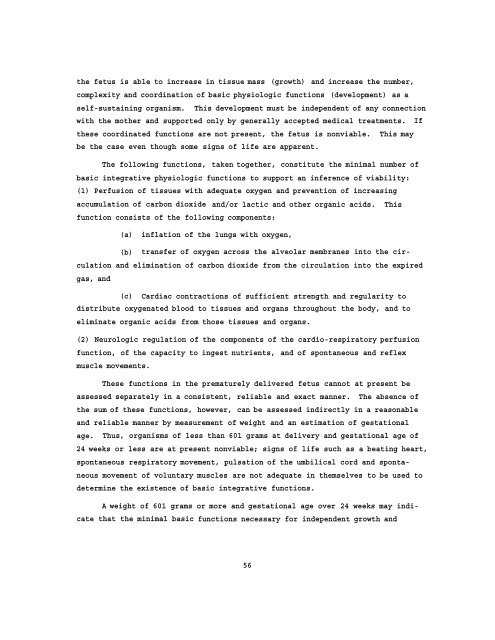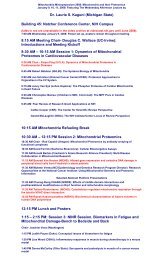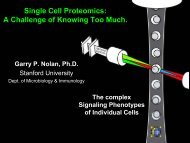RESEARCH ON THE FETUS - National Institutes of Health
RESEARCH ON THE FETUS - National Institutes of Health
RESEARCH ON THE FETUS - National Institutes of Health
You also want an ePaper? Increase the reach of your titles
YUMPU automatically turns print PDFs into web optimized ePapers that Google loves.
the fetus is able to increase in tissue mass (growth) and increase the number,<br />
complexity and coordination <strong>of</strong> basic physiologic functions (development) as a<br />
self-sustaining organism. This development must be independent <strong>of</strong> any connection<br />
with the mother and supported only by generally accepted medical treatments. If<br />
these coordinated functions are not present, the fetus is nonviable. This may<br />
be the case even though some signs <strong>of</strong> life are apparent.<br />
The following functions, taken together, constitute the minimal number <strong>of</strong><br />
basic integrative physiologic functions to support an inference <strong>of</strong> viability:<br />
(1) Perfusion <strong>of</strong> tissues with adequate oxygen and prevention <strong>of</strong> increasing<br />
accumulation <strong>of</strong> carbon dioxide and/or lactic and other organic acids. This<br />
function consists <strong>of</strong> the following components:<br />
(a) inflation <strong>of</strong> the lungs with oxygen,<br />
(b) transfer <strong>of</strong> oxygen across the alveolar membranes into the circulation<br />
and elimination <strong>of</strong> carbon dioxide from the circulation into the expired<br />
gas, and<br />
(c) Cardiac contractions <strong>of</strong> sufficient strength and regularity to<br />
distribute oxygenated blood to tissues and organs throughout the body, and to<br />
eliminate organic acids from those tissues and organs.<br />
(2) Neurologic regulation <strong>of</strong> the components <strong>of</strong> the cardio-respiratory perfusion<br />
function, <strong>of</strong> the capacity to ingest nutrients, and <strong>of</strong> spontaneous and reflex<br />
muscle movements.<br />
These functions in the prematurely delivered fetus cannot at present be<br />
assessed separately in a consistent, reliable and exact manner. The absence <strong>of</strong><br />
the sum <strong>of</strong> these functions, however, can be assessed indirectly in a reasonable<br />
and reliable manner by measurement <strong>of</strong> weight and an estimation <strong>of</strong> gestational<br />
age. Thus, organisms <strong>of</strong> less than 601 grams at delivery and gestational age <strong>of</strong><br />
24 weeks or less are at present nonviable; signs <strong>of</strong> life such as a beating heart,<br />
spontaneous respiratory movement, pulsation <strong>of</strong> the umbilical cord and spontaneous<br />
movement <strong>of</strong> voluntary muscles are not adequate in themselves to be used to<br />
determine the existence <strong>of</strong> basic integrative functions.<br />
A weight <strong>of</strong> 601 grams or more and gestational age over 24 weeks may indicate<br />
that the minimal basic functions necessary for independent growth and<br />
56











